An Atlanta Home’s 60-Year Journey To Vacancy And Disrepair
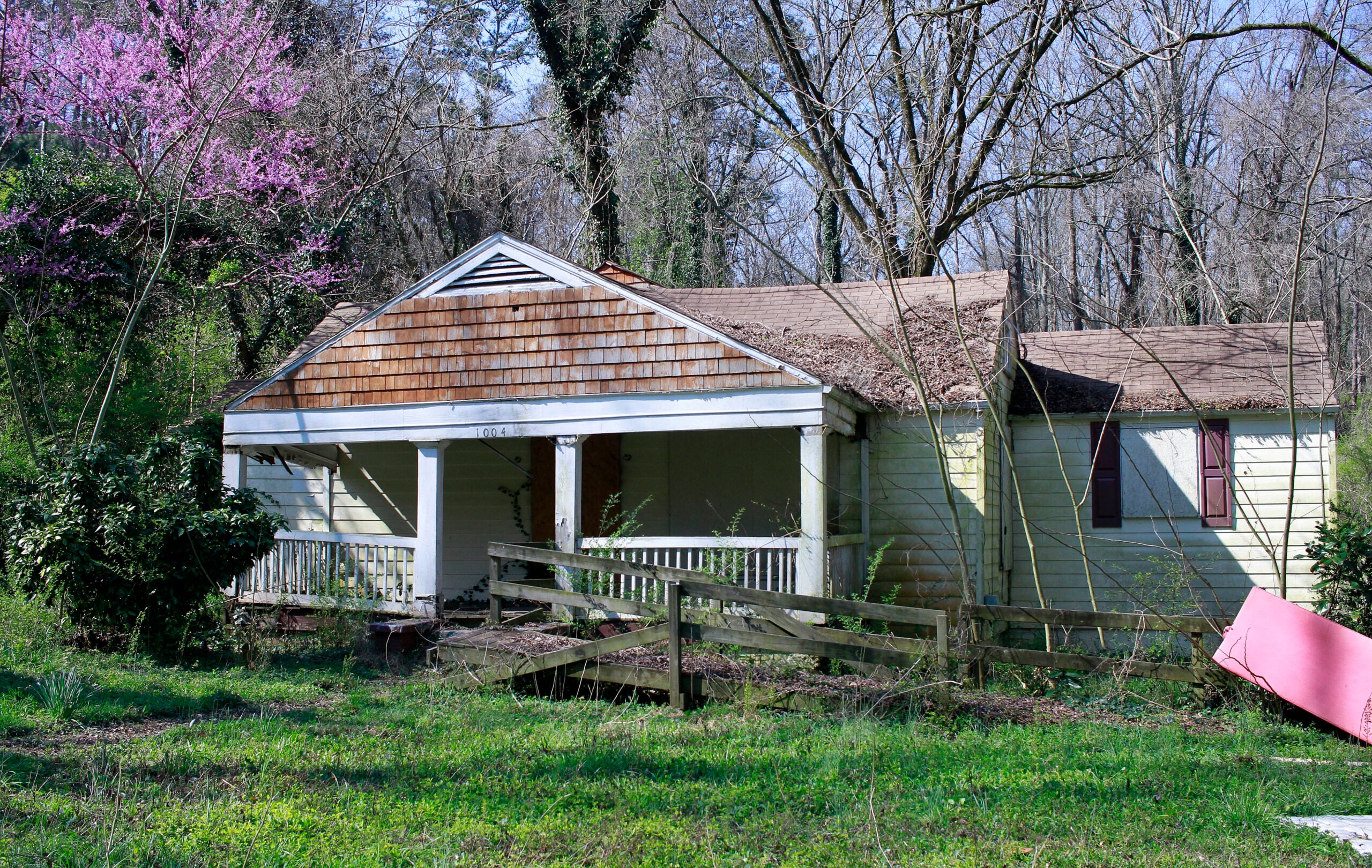
1004 Lookout is a vacant property in Northwest Atlanta. Its journey to becoming an eyesore follows the decline of the neighborhood.
Kaitlin Kolarik / WABE
If you follow Donald Lee Hollowell Parkway west toward the edge of Atlanta city limits, you’ll find a neighborhood called Almond Park.
One resident described the area as a piece of country in the city. The lots are large, and they’re lined with tall trees.
But the property Dustin Hillis, a city council member, came out to see is not so idyllic.
The one-story house is in bad shape. Plywood covers the doors and windows, the gabled roof above the wide front porch is collapsing and mildew has turned the home’s yellow siding green.
The yard has its own problems. It’s filled with trash: things like tires, fast food containers and a surprising number of car bumpers.
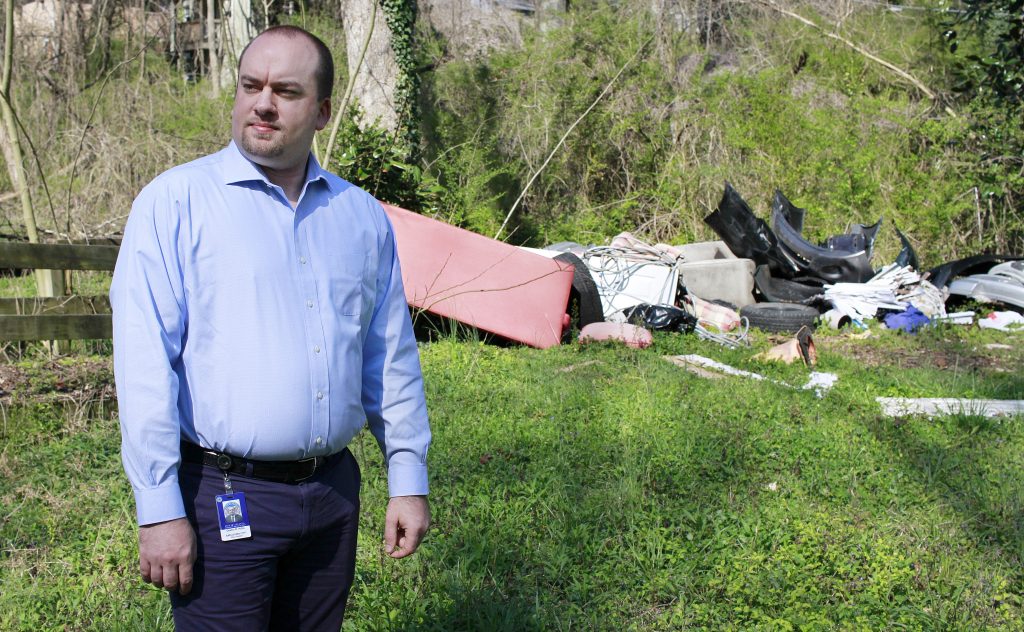
And then there’s the Privet and English Ivy. The plants have swallowed the half-acre backyard, which Hillis said makes him hesitant to explore. He’s not a snake person.
This is 1004 Lookout Ave.
Hillis said the house has been abandoned for years.
“I’ve lost count of the times I’ve driven by it. I’ve actually got out and walked around the house at least five or six times,” he said.
The home is one of the stains on his district that just won’t go away.
And it reveals a problem still undermining some Atlanta neighborhoods. While the center of the city has seen the demand for housing grow, communities to the west and south, like Almond Park, continue to deal with a glut of vacant properties.
So how did 1004 Lookout become one of them? What turned this property into an empty, dilapidated home?
After sifting through property records, visiting the Fulton County deed room and making dozens of calls, WABE was able to reach a handful of the home’s dozen owners over the past 60 years.
The story revealed through their experiences covers more than the life of a single house. It traces the decline of a neighborhood. And it has a few chapters.
Chapter 1
The first chapter starts in the 1950s, when the house at 1004 Lookout was built.
Patsy Crew Skinner and Nancy Crew Rouse explain it was a simple home. The two sisters grew up there.
“The house was always white. The bathroom was on the back of the house because it had been added later,” Skinner said.
“Like an afterthought,” Rouse said.
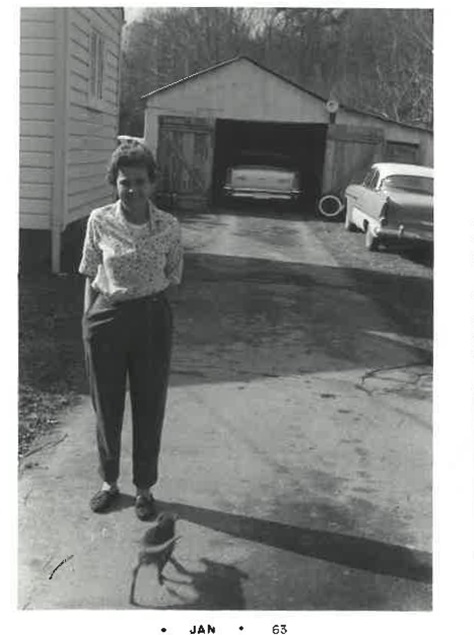
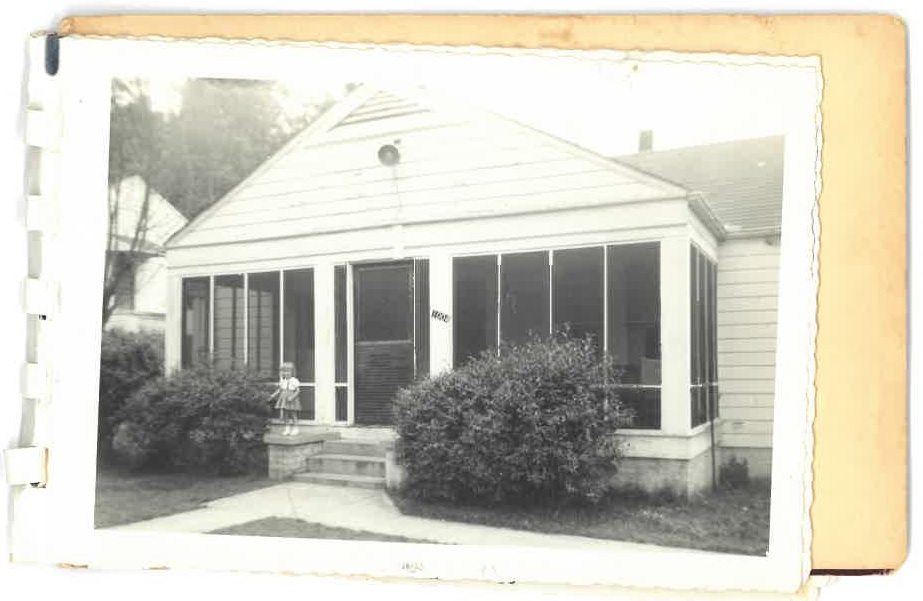
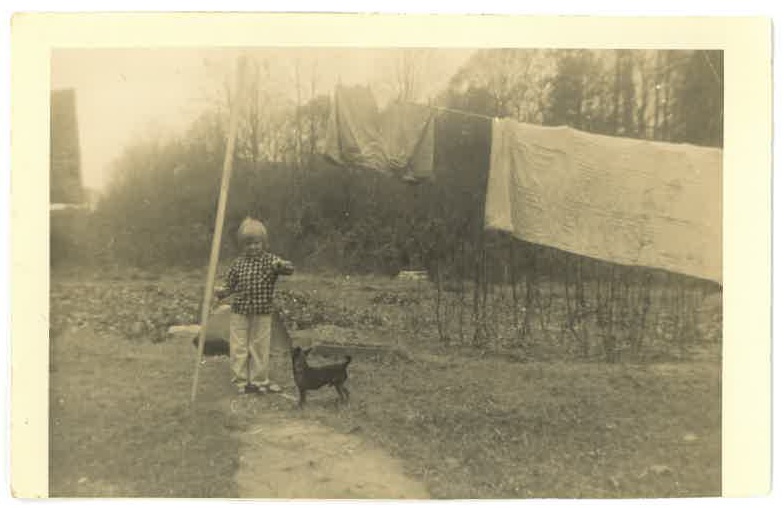
Skinner said they have good memories of the place. They walked to school, played outside. Their dad grew vegetables, like peas, okra and corn, in the backyard.
He also caught rabbits, and went frog hunting, or gigging, in the nearby creek.
“That’s where you wade the creek at night. You have a gig, with a pitchfork-like thing. And you gig the frogs, you take their legs and have fried frog legs,” Skinner said.
“Taste like chicken,” Rouse said.
But in the 1960s, the area began to change.
Almond Park was a white neighborhood, but Atlanta schools were integrating. The Ku Klux Klan held a rally nearby.
“I was old enough and heard people talking about it,” Skinner said. “I did see some Klansmen in white robes. But we weren’t involved in it, and my parents weren’t involved in it.”
Still, their neighbors moved.
Eventually, Skinner’s parents were one of the last white families there. When they retired in the 70s, they sold the house.
This period is key to Almond Park’s troubles.
“With white flight, we saw economic disinvestment occurring,” said Frank Alexander, an Emory professor who founded the Center for Community Progress, a nonprofit focused on vacant properties.
He said as white people left the neighborhood, lenders and developers did too. So that in the years after the area became majority black, it struggled with neglect.
And that leads to the next chapter.
Chapter 2
“The neighborhood was challenged because I remember having concerns,” Nikki said.
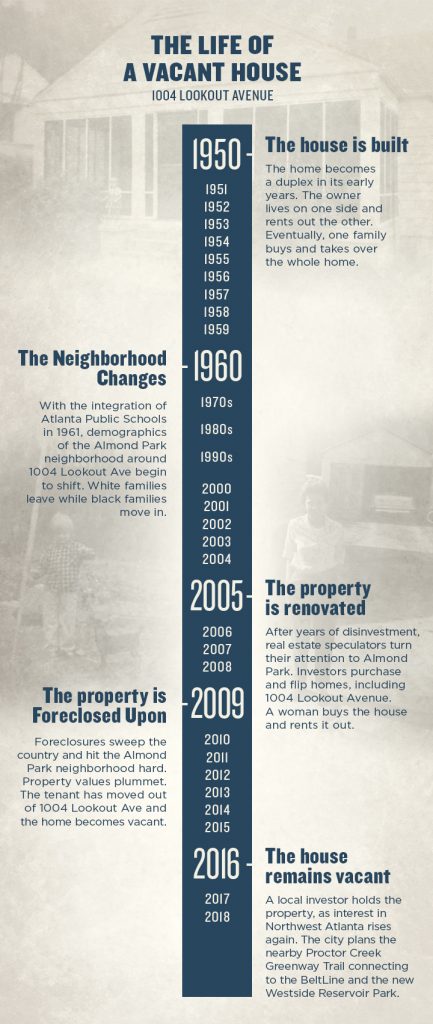
Nikki came to Almond Park decades later, in the early 2000s. She wanted to get into real estate. And speculators had started flipping homes in the area.
She was told the neighborhood would be a good investment.
“The area was going to be coming up in the next three to five years,” Nikki said. “So it was a good time to buy now. And actually rent it out. And let the property value go up and then sell it.”
So despite her doubts, she bought 1004 Lookout in the spring of 2005.
It was $160,000. Nikki said the property looked nice on the outside, and the block around it did too.
“There was new construction on that street. There were houses that they were building. I saw that,” she said. “That’s what made me feel like, this is good.”
Pretty soon, however, appearances didn’t match reality.
The neighborhood didn’t improve, and the home needed a lot of repairs. Nikki said paying the mortgage got tough.
“For whatever reason I couldn’t get it refinanced to get a lower payment,” she said. “So the house ended up foreclosing. The tenant ended up moving out.”
That was in 2009, the middle of the foreclosure crisis.
The experience was bad for Nikki—so much so she doesn’t want to publicize her last name. She’s still a business woman.
And for the neighborhood, the real estate speculation hurt even more.
“It was an artificial bubble nationwide but in this neighborhood it was particularly devastating,” Alexander, the Emory professor, said.
He said the foreclosures left Almond Park littered with vacant homes.
This is a Google Street View from 2007.
Chapter 3
That introduces the third chapter in 1004 Lookout’s story and another owner: Pablo Gill.
“Mostly I was looking for reasonably affordable properties that I could fix up and the rates in this area were ridiculous,” Gill said.
Gill, a small-time investor from Cobb County, found the Lookout house in 2016. By that point, it had been empty for years. The price had dropped down to just $7,000.
“It was definitely a fixer upper. I knew I was in for a project. But I wasn’t quite expecting to see as much struggle as I have,” he said.
By struggle, Gill means blight in the area. He said he hoped to see new development.
The city of Atlanta invested in a trail system nearby to connect to the BeltLine. There’s also a new park planned, Westside Reservoir Park.
But so far, Gill has only seen trash.
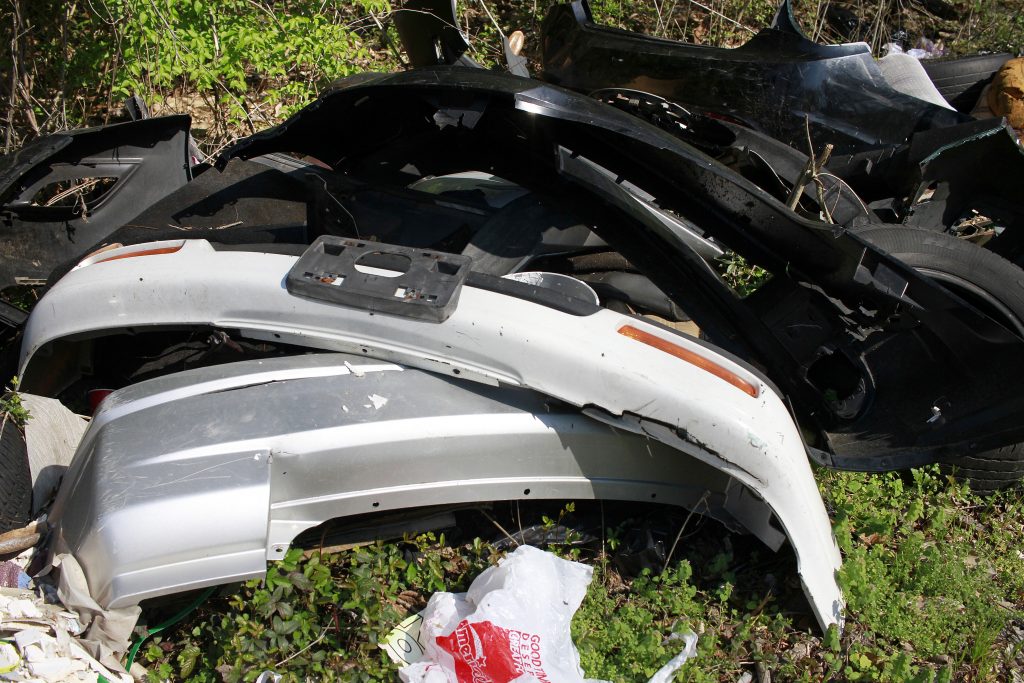
“It’s very difficult to keep the area clean. I’m constantly over there getting rid of stuff dumped on my property,” Gill said.
He said it’s keeping home values down.
And that’s why he’s let 1004 Lookout sit vacant: Improving the house isn’t worth his money.
“It doesn’t make sense to rebuild something that I could only get $30,000-40,000 in this condition,” he said.
The End?
That’s how 1004 Lookout became an eyesore.
Frank Alexander said the narrative isn’t unique to this house or even Almond Park.
“In neighborhoods where it is a weak market, it is not at all uncommon that homes will become over time deteriorated,” he said.
Many even follow the same route as the Lookout house—going from homeownership, to rental, to vacant and investor-owned.
Alexander said inevitably a strong real estate market will return to this part of Northwest Atlanta because people want to live in the city again.
“The supply of land inside the city of Atlanta is limited and the good news for Atlanta is the demand is increasing,” he said.
Still, cities can intervene before the private market does.
Alexander’s nonprofit advises local governments on how to compel owners to better properties and even seize them if necessary. His group provided a report to the city of Atlanta in 2014 detailing solutions to abandoned lots.
For now, though, it seems the home at 1004 Lookout will remain as it is.
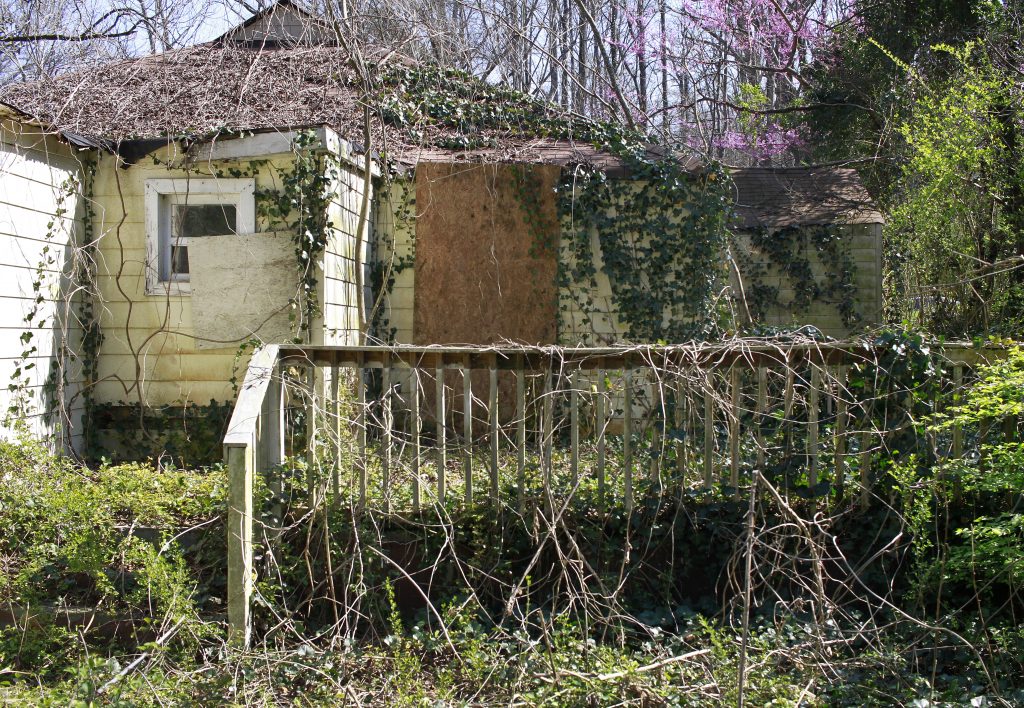
Council member Hillis said code enforcement did cite the property. Officers decided it was overgrown. Now city workers will come clean it up.
Hillis said the area may be clear for a moment.
“Then I’ll have neighbors calling, or I’ll drive by here six months later, and the weeds will be six feet tall,” he said.
And Hillis predicts the dumping will start over.
The yard will fill up again. With things like tires, fast food containers and another dozen car bumpers.









